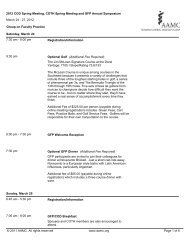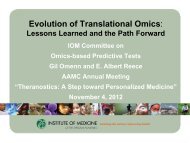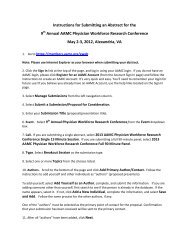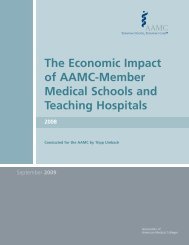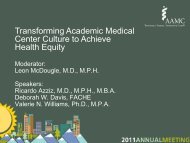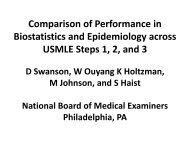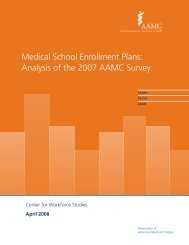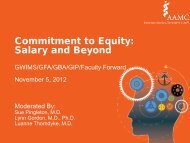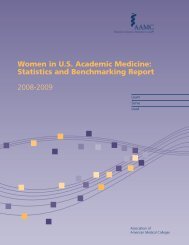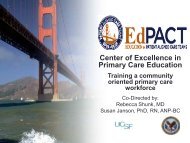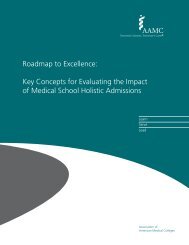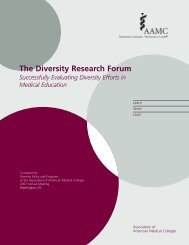Religious Diversity in Health Care
Religious Diversity in Health Care
Religious Diversity in Health Care
Create successful ePaper yourself
Turn your PDF publications into a flip-book with our unique Google optimized e-Paper software.
<strong>Religious</strong> <strong>Diversity</strong> <strong>in</strong> <strong>Health</strong> <strong>Care</strong><br />
Promot<strong>in</strong>g <strong>Health</strong> Equity and Inclusion<br />
Group on <strong>Diversity</strong> and Inclusion<br />
November 2, 2012<br />
San Francisco
Moderator:<br />
Ann-Christ<strong>in</strong>e Nyquist, M.D., M.S.P.H.<br />
Associate Dean for <strong>Diversity</strong> and Inclusion<br />
University of Colorado School of Medic<strong>in</strong>e<br />
Speakers:<br />
Mark E. Fowler<br />
Manag<strong>in</strong>g Director of Programs<br />
Tanenbaum Center for Interreligious Understand<strong>in</strong>g<br />
Joseph Betancourt, M.D., M.P.H.<br />
Associate Professor of Medic<strong>in</strong>e<br />
Massachusetts General Hospital<br />
2012 AAMC Annual Meet<strong>in</strong>g
Objectives<br />
1. Understand why religio-cultural competency<br />
must be addressed <strong>in</strong> a health care sett<strong>in</strong>g as it<br />
relates to the quality and equality of patient<br />
care.<br />
2. Demonstrate the <strong>in</strong>tersection of religion and<br />
health care <strong>in</strong> areas such as conscience rules,<br />
modesty, end-of-life and reproductive health.<br />
3. Identify key strategies for improv<strong>in</strong>g the<br />
education and tra<strong>in</strong><strong>in</strong>g of health care<br />
professionals around religio-cultural<br />
competence.<br />
2012 AAMC Annual Meet<strong>in</strong>g
<strong>Religious</strong> <strong>Diversity</strong> <strong>in</strong> <strong>Health</strong> <strong>Care</strong><br />
Mark E. Fowler<br />
Manag<strong>in</strong>g Director of Programs<br />
Tanenbaum Center for<br />
Interreligious Understand<strong>in</strong>g
Objectives<br />
• WHY does religio-cultural competence need to<br />
be addressed <strong>in</strong> a health care sett<strong>in</strong>g?<br />
• WHEN do religion and health care <strong>in</strong>tersect?<br />
• HOW can we improve the education and<br />
tra<strong>in</strong><strong>in</strong>g of health care professionals around<br />
religio-cultural competence?<br />
2012 AAMC Annual Meet<strong>in</strong>g
I always treat people of other religious faiths with<br />
respect.<br />
People of other religious faiths always treat me<br />
with respect.<br />
2012 AAMC Annual Meet<strong>in</strong>g
AWARENESS:<br />
Why is Religion Important?<br />
2012 AAMC Annual Meet<strong>in</strong>g
Cultural Competence<br />
Sexual<br />
Orientation<br />
National<br />
Orig<strong>in</strong><br />
Language<br />
Access<br />
Ethnicity<br />
Gender<br />
Race<br />
RELIGION<br />
Socio-<br />
Economic<br />
Status<br />
2012 AAMC Annual Meet<strong>in</strong>g
U.S. Immigration Trends<br />
8.4<br />
2.7 2<br />
3.8<br />
6.1<br />
18.8<br />
8.6<br />
31.1 42.5 51.7 54<br />
North America<br />
Lat<strong>in</strong> America<br />
62<br />
18<br />
36.6<br />
25.2<br />
22<br />
26.4 28.2<br />
15.8 12.7<br />
Africa<br />
Asia<br />
Europe<br />
1970 1980 1990 2000 2010<br />
American Community Survey. (2010). Birthplace of the Foreign Population.<br />
2012 AAMC Annual Meet<strong>in</strong>g
<strong>Health</strong> <strong>Care</strong> Workforce Trends<br />
• 22% of U.S. health care workers are foreignborn,<br />
compared to 13% of the U.S. workforce<br />
overall:<br />
• Physicians: 28%<br />
• Registered Nurses: 15%<br />
• 25% of today’s foreign-born health care workers<br />
immigrated to the U.S. after the year 2000.<br />
Carnevale, A., Gulish, A., Smith, N. & Beach, B. (2012). <strong>Health</strong>care. Georgetown University Center on Education and the Workforce. Retrieved<br />
from: http://www9.georgetown.edu/grad/gppi/hpi/cew/pdfs/<strong>Health</strong>care.FullReport.070312.pdf<br />
2012 AAMC Annual Meet<strong>in</strong>g
Religiosity <strong>in</strong> the U.S.<br />
Accord<strong>in</strong>g to a 2010 Gallup Poll:<br />
• 92%: I believe <strong>in</strong> God.<br />
• 80%: Religion is very important/fairly important<br />
<strong>in</strong> my life.<br />
• 65%: Religion is an important part of daily life.<br />
• 58%: I believe that religion can answer all or<br />
most of today’s problems.<br />
Gallup Poll 2010: http://www.gallup.com/poll/1690/religion.aspx#1<br />
2012 AAMC Annual Meet<strong>in</strong>g
How Many Religions?<br />
Atheism<br />
Russian Orthodox<br />
Sh<strong>in</strong>to<br />
Agnostic<br />
Santeria<br />
Buddhism<br />
Shi’a Muslim<br />
Wiccan<br />
Southern Baptist<br />
H<strong>in</strong>duism<br />
Rastafarianism Eastern Orthodox Unitarianism<br />
Ja<strong>in</strong>ism<br />
Sikhism<br />
Evangelical Christian Jehovah’s Witness<br />
Voudon<br />
Lutheran<br />
Protestant<br />
Taoism<br />
Pentecostal Baha’i<br />
Paganism<br />
Alaska Native Orthodox Judaism<br />
Zoroastrianism<br />
Sunni Muslim<br />
Confucianism Candomble<br />
Hasidic<br />
Methodist<br />
Mormonism<br />
resbyterianism<br />
Mahayana Reform Judaism Conservative Judaism<br />
Spiritual<br />
oman Catholic American Indian<br />
Seventh Day Adventist<br />
2012 AAMC Annual Meet<strong>in</strong>g
<strong>Religious</strong> <strong>Diversity</strong> <strong>in</strong> the U.S.<br />
The Pew Forum on Religion and Public Life. (2007)<br />
2012 AAMC Annual Meet<strong>in</strong>g
What do patients want?<br />
• 41% of patients want to discuss religious<br />
concerns.<br />
• Only half report hav<strong>in</strong>g such a discussion.<br />
• Only 8% have this discussion with a doctor.<br />
• 41% of patients can th<strong>in</strong>k of a time when<br />
religious beliefs <strong>in</strong>fluence a health care decision<br />
they make.<br />
Williams, J., Meltzer, D., Arora, V., Chung, G., & Curl<strong>in</strong>, F. (2011). Attention to <strong>in</strong>patients’ religious and spiritual concerns: Predictors and association with<br />
patient satisfaction. Journal of General Internal Medic<strong>in</strong>e. July, 1 Published Onl<strong>in</strong>e.<br />
2012 AAMC Annual Meet<strong>in</strong>g
What are doctors do<strong>in</strong>g?<br />
• 91% of physicians agree that it is appropriate to<br />
discuss religious issues when the patient br<strong>in</strong>gs<br />
them up.<br />
• 55% feel it is appropriate to proactively address<br />
a patient’s religious concerns.<br />
However…<br />
• Only 10% of physicians report do<strong>in</strong>g so on a<br />
regular basis.<br />
Curl<strong>in</strong>, F., Ch<strong>in</strong>, M., Sellergren, S., Roach, C., & Lantos, J. (2006). The association of physicians’ religious characteristics with their attitudes<br />
and self-reported behaviors regard<strong>in</strong>g religion and spirituality <strong>in</strong> the cl<strong>in</strong>ical encounter. Medical <strong>Care</strong>. 44(5), 446-453.<br />
2012 AAMC Annual Meet<strong>in</strong>g
Accreditation Standards<br />
Liaison Committee on Medical Education:<br />
Educational Objective: ED-21<br />
“The faculty and students must demonstrate an<br />
understand<strong>in</strong>g of the manner <strong>in</strong> which people of<br />
diverse cultures and belief systems perceive<br />
health and illness and respond to various<br />
symptoms, diseases, and treatments.”<br />
Curl<strong>in</strong>, F., Ch<strong>in</strong>, M., Sellergren, S., Roach, C., & Lantos, J. (2006). The association of physicians’ religious characteristics with their attitudes<br />
and self-reported behaviors regard<strong>in</strong>g religion and spirituality <strong>in</strong> the cl<strong>in</strong>ical encounter. Medical <strong>Care</strong>. 44(5), 446-453.<br />
2012 AAMC Annual Meet<strong>in</strong>g
KNOWLEDGE:<br />
When do Religion & <strong>Health</strong> <strong>Care</strong> Intersect?<br />
2012 AAMC Annual Meet<strong>in</strong>g
Trigger Topics<br />
Dietary<br />
Requirements<br />
Dress & Modesty<br />
Traditional and<br />
Alternative remedies<br />
Organ Transplants<br />
and Donations<br />
Acceptance of<br />
Drugs & Procedures<br />
Blood and Blood<br />
Products<br />
Hygiene<br />
Reproductive <strong>Health</strong><br />
Conscience Rules<br />
Informed Consent<br />
Pregnancy & Birth<br />
Prayer with Patients<br />
Observance of Holy<br />
Days and Rituals<br />
End-of-Life<br />
Proselytiz<strong>in</strong>g<br />
2012 AAMC Annual Meet<strong>in</strong>g
Trigger Topics:<br />
• Dress & Modesty: A hospital <strong>in</strong> Ma<strong>in</strong>e discovers that Muslim<br />
women are not com<strong>in</strong>g <strong>in</strong> for care due to the immodest gowns.<br />
• End-of-Life: A young Jewish girl is declared bra<strong>in</strong> dead but the<br />
parents refuse to withdraw care. They do not view bra<strong>in</strong> stem<br />
death as death.<br />
• Dietary Requirements: A son is horrified to discover that his<br />
mother, a H<strong>in</strong>du and life-long vegetarian who suffers from<br />
dementia, was served (and ate) a non-vegetarian meal.<br />
• Reproductive <strong>Health</strong>: A Catholic mother refuses to consider<br />
allow<strong>in</strong>g her daughter to use birth-control pill as a treatment<br />
option for endometriosis.<br />
• Conscience Rules: An Evangelical Christian physician refuses<br />
to provide fertility treatment for a lesbian couple<br />
2012 AAMC Annual Meet<strong>in</strong>g
CHALLENGES & OPPORTUNITIES:<br />
Religio-Cultural Competence <strong>in</strong> Medical<br />
Education<br />
2012 AAMC Annual Meet<strong>in</strong>g
<strong>Religious</strong> <strong>Diversity</strong> <strong>in</strong> <strong>Health</strong> <strong>Care</strong><br />
Joseph Betancourt, M.D., M.P.H.<br />
Associate Professor of Medic<strong>in</strong>e<br />
Massachusetts General Hospital
What do medical tra<strong>in</strong>ees tell us?<br />
Residents Preparedness to <strong>Care</strong> for<br />
Diverse Populations<br />
JAMA 2005<br />
•Residents located <strong>in</strong> programs affiliated with 160 academic health<br />
center hospitals<br />
•F<strong>in</strong>al year of tra<strong>in</strong><strong>in</strong>g<br />
•N=2047 (RR=60%)<br />
•Seven Specialties<br />
1) Emergency Med (EM) 2) Family Med (FM)<br />
3) Internal Med (IM) 4) OB/GYN<br />
5) Pediatrics (Ped) 6) Psychiatry (PSY)<br />
7) General Surgery (Surg)<br />
2012 AAMC Annual Meet<strong>in</strong>g
Good News – The “Buy-In” is<br />
There<br />
97% of residents feel that it is<br />
“moderately” or “very<br />
important” for physicians <strong>in</strong><br />
their specialty “to consider the<br />
patient’s culture when provid<strong>in</strong>g<br />
care”.<br />
2012 AAMC Annual Meet<strong>in</strong>g
… and, Residents Perceive<br />
Consequences for the <strong>Health</strong><br />
<strong>Care</strong> System & Patients<br />
% of Residents Who Said Cross-Cultural<br />
Patient Issues Resulted “Often” <strong>in</strong> the<br />
follow<strong>in</strong>g consequences<br />
Longer than average visits 41%<br />
Non-compliance w/ treatment 20%<br />
Delays obta<strong>in</strong><strong>in</strong>g consent 18%<br />
Unnecessary visits 14%<br />
Unnecessary tests 9%<br />
Unnecessary hospitalization 5%<br />
2012 AAMC Annual Meet<strong>in</strong>g
Many Residents Feel Unprepared to Deliver<br />
Specific Components of Cross-Cultural <strong>Care</strong><br />
“How prepared do you feel to<br />
care for [follow<strong>in</strong>g types of]<br />
patients (or pediatric patients’<br />
families)…?<br />
% Very or<br />
Somewhat<br />
Unprepared<br />
General<br />
Specific<br />
Culture different from own 8%<br />
Racial/ethnic m<strong>in</strong>ority 4.6%<br />
<strong>Health</strong> beliefs at odds w/ Western medic<strong>in</strong>e 25%<br />
With distrust of U.S. health system 28%<br />
Limited English proficiency 21%<br />
New immigrants 25%<br />
Whose religious beliefs affect treatment 19%<br />
Who use alternative/complementary medic<strong>in</strong>e 26%<br />
2012 AAMC Annual Meet<strong>in</strong>g
Tra<strong>in</strong><strong>in</strong>g Matters: Residents with Little<br />
Instruction Dur<strong>in</strong>g Residency Much More<br />
Likely to Perceive Low Skill Levels<br />
% of Residents with Low Perceived<br />
Skill Levels (1,2) by amount of<br />
<strong>in</strong>struction<br />
None/<br />
Vy Little<br />
Instruct’n<br />
Lot of<br />
Instruct’n<br />
How patients want to be addressed 10% 1%<br />
Assess understand<strong>in</strong>g of illness 11% 1%<br />
Identify relevant religious beliefs 40% 2%<br />
Identify relevant cultural customs 38% 5%<br />
Work with <strong>in</strong>terpreter 18% 0.4%<br />
2012 AAMC Annual Meet<strong>in</strong>g
Problems when Deliver<strong>in</strong>g<br />
Cross-Cultural <strong>Care</strong><br />
Percent Say<strong>in</strong>g Each Was a<br />
Problem When Deliver<strong>in</strong>g Cross-<br />
Cultural <strong>Care</strong><br />
60<br />
50<br />
40<br />
30<br />
20<br />
10<br />
0<br />
19<br />
2<br />
Lack<br />
Experience<br />
42<br />
14<br />
Lack<br />
Time<br />
Inadequate<br />
Tra<strong>in</strong><strong>in</strong>g<br />
26 24<br />
Mod. problem<br />
Big problem<br />
13<br />
5 7 4<br />
Lack<br />
Role<br />
Models<br />
Dismissive<br />
Attitudes of<br />
Attend<strong>in</strong>gs<br />
2012 AAMC Annual Meet<strong>in</strong>g
So what does this all mean?<br />
Tra<strong>in</strong>ees want to do the right th<strong>in</strong>g, and understand<br />
that if they don’t it impacts quality, but…<br />
• They don’t want to be lectured with the assumption they<br />
are broken and need to be fixed<br />
• They often view cultural competence as:<br />
• Someth<strong>in</strong>g that just <strong>in</strong>creases visit time, not a skill set<br />
• Soft-science without an evidence-based<br />
• Sometimes they want “just the facts” about cultures<br />
• Tra<strong>in</strong><strong>in</strong>g matters<br />
2012 AAMC Annual Meet<strong>in</strong>g
Success is all <strong>in</strong> the pitch…<br />
Cultural competence needs to be framed as…<br />
• A skill set, like a review of systems, or checklist, that can<br />
help you with challeng<strong>in</strong>g cases<br />
• Practical, actionable, and time-efficient<br />
It needs to be taught…<br />
• In a case-based fashion, creat<strong>in</strong>g cl<strong>in</strong>ical challenges<br />
• With a l<strong>in</strong>k to EBG and Peer-Reviewed Literature<br />
• And leave you with a set of tools and skills<br />
2012 AAMC Annual Meet<strong>in</strong>g
Model for Cross-Cultural <strong>Care</strong>:<br />
A Patient-Based Approach<br />
Awareness<br />
of Cultural<br />
and Social<br />
Factors<br />
Elicit<br />
Factors<br />
Negotiate<br />
Models<br />
Implement<br />
Management<br />
Strategies<br />
Avoid stereotypes and build trust<br />
Tools and skills necessary to provide quality<br />
care to any patient we see, regardless of race,<br />
ethnicity, culture, class or language proficiency.<br />
2012 AAMC Annual Meet<strong>in</strong>g
Case Example and Key Lessons<br />
• Quality Interactions Cross-Cultural Tra<strong>in</strong><strong>in</strong>g mandatory for 3 rd yr at HMS<br />
• Case-based, <strong>in</strong>teractive, uses adult-learn<strong>in</strong>g theory and creates teachable<br />
moments; l<strong>in</strong>ks to evidence-based guidel<strong>in</strong>es and the peer-reviewed literature<br />
• More than 88% said program <strong>in</strong>creased awareness of issues, would improve<br />
care they provide to patients, and would recommend to colleagues; average<br />
pretest score 51%, posttest score 83%<br />
1. Available at: http://www.quality<strong>in</strong>teractions.org/prod_overview/cl<strong>in</strong>ical_program_features.html.<br />
2012 AAMC Annual Meet<strong>in</strong>g
MOVING FORWARD:<br />
Recommendations for Better Practices<br />
2012 AAMC Annual Meet<strong>in</strong>g
Challenges to Cross-Cultural Education:<br />
An Uphill Battle Learners, Teachers and Integration<br />
Learner<br />
• “Soft”, marg<strong>in</strong>alized issues requir<strong>in</strong>g buy-<strong>in</strong><br />
• Desire for categorical approach<br />
• Time constra<strong>in</strong>ts<br />
*Resistance varies across the cont<strong>in</strong>uum<br />
Teacher<br />
• Vary<strong>in</strong>g fundamental approaches and teach<strong>in</strong>g<br />
methodologies<br />
• Limited time, fund<strong>in</strong>g, <strong>in</strong>stitutional support<br />
2012 AAMC Annual Meet<strong>in</strong>g
Strategies for Integration:<br />
Five Lessons from the Field<br />
1. “Buy-In” is critical<br />
• L<strong>in</strong>k to quality; curriculum will assist you<br />
2. Focus on cases<br />
• Straight didactics quickly forgotten<br />
3. Address demand for “categorical approach”<br />
• Emphasize pitfalls; development of framework similar to<br />
those used <strong>in</strong> the cl<strong>in</strong>ical encounter<br />
2012 AAMC Annual Meet<strong>in</strong>g
Strategies for Integration:<br />
Five Lessons from the Field<br />
4. Th<strong>in</strong>k longitud<strong>in</strong>ally<br />
• Development of attitudes, knowledge and skills over<br />
time, respect<strong>in</strong>g stage of development<br />
5. Integrate when possible<br />
• Identify natural synergies and allies; consider compet<strong>in</strong>g<br />
<strong>in</strong>terests<br />
2012 AAMC Annual Meet<strong>in</strong>g
Institutionalization<br />
Secure buy-<strong>in</strong><br />
Assess needs<br />
Develop curricular tools<br />
Implement/Integrate<br />
Evaluate efficacy<br />
Adjust & Improve<br />
Re<strong>in</strong>force/Institutionalize<br />
2012 AAMC Annual Meet<strong>in</strong>g
Key Players<br />
Medical School<br />
• Dean, <strong>Diversity</strong> &<br />
Inclusion<br />
• Course Directors<br />
• Dean, Medical<br />
Education<br />
• Dean, Medical School<br />
Hospital System<br />
• Cl<strong>in</strong>ical Staff<br />
• Director of Patient<br />
Experience<br />
• Director of Pastoral<br />
<strong>Care</strong><br />
• Director of Cultural<br />
Competence/<strong>Diversity</strong><br />
• Hospital CEO<br />
2012 AAMC Annual Meet<strong>in</strong>g
Save the Dates!<br />
GDI Professional<br />
Development Conference<br />
May 16-19, 2013<br />
Fairmont Royal York Hotel<br />
Toronto, Canada<br />
GSA/GDI/OSR National<br />
Meet<strong>in</strong>g<br />
April 26-29, 2014<br />
Hilton Bayfront Hotel<br />
San Diego, California<br />
2012 AAMC Annual Meet<strong>in</strong>g



